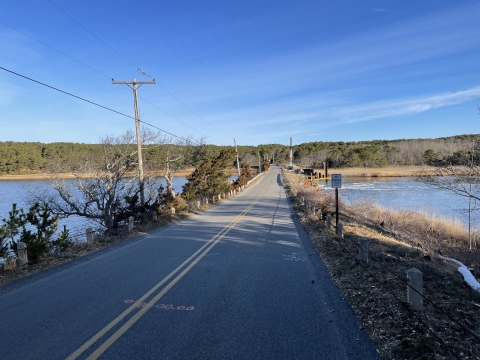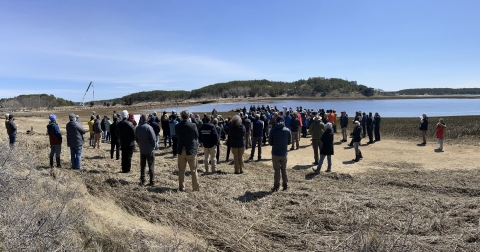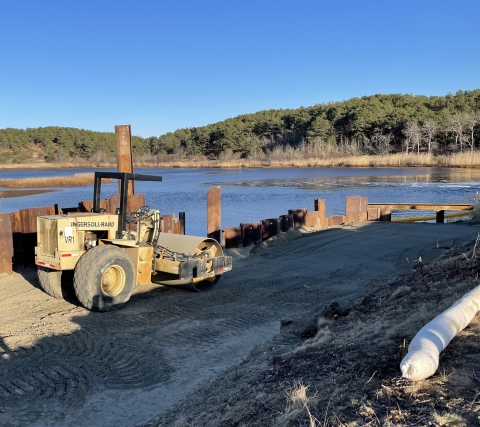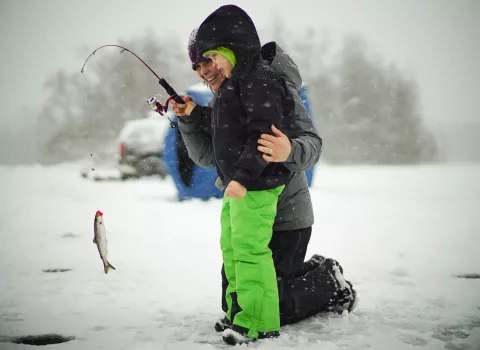Twice a day, high tide fills salt marsh salt marsh
Salt marshes are found in tidal areas near the coast, where freshwater mixes with saltwater.
Learn more about salt marsh creeks with nutrient-rich ocean waters that feed these vital estuaries and their inhabitants, from ospreys to river herring to eastern oysters.
But for more than a century, the rising tide has hit a wall at the mouth of the largest tidal river on Cape Cod, Massachusetts.
In 1909, in a misguided attempt to reduce breeding habitat for mosquitoes, the state funded construction of an earthen dike at the opening of the Herring River in Wellfleet, restricting tidal flow to the nearly 900-acre estuary.
Cutting off the river from saltwater launched a downward spiral for the once-mighty marsh, ushering in an era of fish kills, invasive species invasive species
An invasive species is any plant or animal that has spread or been introduced into a new area where they are, or could, cause harm to the environment, economy, or human, animal, or plant health. Their unwelcome presence can destroy ecosystems and cost millions of dollars.
Learn more about invasive species , bacterial contamination, marsh subsidence, and ironically, more mosquitoes.
These were all symptoms of an unhealthy marsh that could no longer provide high-quality habitat to wildlife and associated benefits to people, like storm protection.
Opening day
Now, the wall between the Herring River and the tides is coming down. Or rather, opening up.
After years of planning, conservation partners broke ground on the first phase of a project to replace a portion of the dike with a new bridge, outfitted with sluice gates that will be opened incrementally to restore full tidal flow to the system once again.
The groundbreaking is a milestone for the town, and for the broader conservation community — it signals the first phase of the largest salt marsh restoration in the eastern U.S.
"We're thrilled to be a partner in restoring the Herring River to a naturally functioning tidal marsh that is more resilient to climate change climate change
Climate change includes both global warming driven by human-induced emissions of greenhouse gases and the resulting large-scale shifts in weather patterns. Though there have been previous periods of climatic change, since the mid-20th century humans have had an unprecedented impact on Earth's climate system and caused change on a global scale.
Learn more about climate change and supports wildlife and people," said Wendi Weber, Deputy Director for the U.S. Fish and Wildlife Service. “This conservation project is a great example of the type of durable, nature-based solution that results from locally driven efforts and is needed up and down the coast."
It’s also a testament to the dedication of partners.
It takes a village
For more than a decade, the Town of Wellfleet has been working with the National Park Service — most of the Herring River system lies within the boundaries of Cape Cod National Seashore — to plan the restoration project, based on years of research that demonstrated the need for it.
Numerous other partners have played key roles in the effort, including the National Oceanic and Atmospheric Administration, the U.S. Department of Agriculture’s Natural Resources Conservation Service, the Massachusetts Department of Fish and Game’s Division of Ecological Restoration, and the nonprofit Friends of Herring River.
For its part, the Service has provided technical support through our Partners for Fish and Wildlife and Coastal programs, and engineering design support through our Fisheries program. Last year, our Migratory Birds program awarded a $2-million North American Wetlands Conservation Act grant to Ducks Unlimited to help fund the restoration.
The project has been hailed as a nationally significant model for using science and smart investments in infrastructure to repair environmental damage, increase community resilience, and support the local economy.
A new era
What will that look like on the ground?
Picture a homecoming.
Over time, the river herring run, once among the largest in New England, will return, as migratory fish like alewife can once again reach historic spawning grounds. Commercially valuable fish species that feed on herring, like cod and haddock, will also benefit.
Returning tidal flow will carry nutrients and sediments needed for the marsh to rebuild, and eventually, the saltmarsh sparrow, a species that breeds solely in the salt marshes of the Northeast, will find the high-marsh habitat it needs to nest.
As water quality improves thanks to twice daily tidal flushing, the area will support a resurgence of eastern oysters and oyster farming.
With six miles of creeks to explore, canoers and kayakers will reappear too.
And the marsh will once again be a nursery for small fish that feed on mosquito larvae.
Ripple effects
Other benefits will be harder to see.
For more than a century, the degraded marsh has released carbon dioxide and methane into the atmosphere. The return of tidal flow will reverse that process, rebuilding peat soils that sequester carbon. Revived marsh vegetation will add to climate benefits.
A healthier marsh will also absorb storm surge and floodwaters from increasingly frequent intense storms, offering nearly a billion dollars’ worth of protection from hurricanes to people and property.
Not to mention, the construction work required to complete the project, currently estimated at about $70 million, is expected to generate between $112 and $126 million in regional economic output and create between 1,120 and 1,680 jobs.
And the new bridge, designed to modern standards, will enhance public safety on the road and in the waterway.
Turning tides
They say time and the tide wait for no one.
For more than 100 years, the tides have risen and fallen each day, while the Herring River has waited for their return.
The wait is finally over.
The tide will once again bring life into the Herring River’s creeks, and vitality to the surrounding community.








